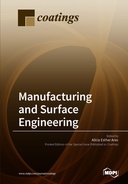Explore

Manufacturing and Surface Engineering
Alicia Esther Ares
2018
0 Ungluers have
Faved this Work
Login to Fave
The desired properties of surface components include the improvement of different properties, such as aesthetic appearance, oxidation resistance, wear resistance, mechanical properties, electronic or electrical properties, thermal insulation, wear, triboemission and corrosion resistance through barriers.These properties can be enhanced using different methods, such as by adding a coating. Nevertheless, the bulk of the material or substrate cannot be considered independent of the surface treatment. Metal cutting is one of the general machining methods used to achieve high accuracy and productivity for metal parts.The topics of the book “Manufacturing and Surface Engineering” include the full range of surface engineering aspects, i.e., surface integrity, contact mechanics, friction and wear, coatings and surface treatments, multiscale tribology, computational methods, and optimization techniques applied in surface engineering.Recent experimental works by Zhang, Li, Zhang, Zhang and Duan, and by other researchers outlined that coating layer surface treatments may increase the damping behavior of thin-walled mechanical components vibrating in flexural conditions. Nevertheless, it was also experimentally found by the authors that most of these coating surface treatments had a negligible or null effect with respect to the vibrational damped response in testing or operating conditions. Ciniero, Le Rouzic and Reddyhoff report the potential of measuring charged particle emissions and/or tribocharging for the study or monitoring of the failure of coatings. The spatial information of triboemission allows the identification of the exact time and location of the failure. The evolution of the failure during sliding and the change in the characteristics of the contact are also monitored. After studying the effect of the Ti content on the performance of FeCoCrNiAlTix, He, Zhang, Lin, Zhang, Dong and Li establish that the structure of FeCoCrNiAlTix coatings consists of two kinds of BCC phases. With the continuous increase in Ti content, the number of eutectic structures decreases, accompanying the increase in the proeutectic phase and the Ti-rich second phase is precipitated out. Abutaha, Abdul Razak, and Ibrahim developed an experimental investigation into the engineering properties of concrete incorporating POC as an aggregate and filler material. This approach offers an environmentally-friendly solution to the ongoing waste problems associated with palm oil waste material.Liu and Janssen studied the effects of impact on the wear of the structural steel S235 in various liquids. When the impact is small, corrosion plays a dominant role, thus the sample in seawater wears the least due to the beneficial interaction with abrasion. However, when the impact is large, the wear rates of three liquids do not show a noticeable difference, because the wear mechanism changes from material removal to mainly plastic deformation. The influence of corrosion becomes a minor influencing factor when subject to impact.Vázquez Martínez, Salguero Gómez, Batista Ponce and Botana Pedemonte analyzed the different treatments obtained through setup parameter combinations to obtain samples with widely varying features, according to the thickness of the treated layer and the incidence depth of the laser beam. This diversity of samples shows a range of color tonalities from soft gold to medium gray and blue. Microstructural changes and oxidation layer generation provide a significant increase in the material hardness, reaching Vickers hardness values close to 1000 HV for high intensity treatments.Takada and Sasahara studied the FSB process using four levels of tip radius burnishing tools and investigated their effect on surface roughness, hardness and residual stress for a 0.45% C steel shaft. The thickness of the hardened layer increased as the tool tip radius decreased. The hardness value of the processed layer reached 600 HV. The residual stress on the processed surface was compressive when a radius tool with a smaller tip was used, and the residual stress turned tensile when a radius tool with a larger tip was used.Vereschaka, Kataeva, Sitnikov, Aksenenko, Oganyan and Sotova searched for patterns that allow a reliable justification for the choice of the composition of coatings and their micro- and nanostructures depending on the material being machined and the cutting regimes (in particular, the cutting speed).Amadori, Catania and Casagrande investigated experimentally eight different innovative composite solutions. A significant increase in the damping behavior was observed for all of these solutions with respect to the uncoated components, and with respect to the already known solutions that have previously been investigated by these authors and other researchers. The coating solution employing an Al2O3 powder + matrix, made using a screen-printing and curing technology on an Al alloy substrate, proved to be the most effective technology with respect to the aim of this work. Catania and Strozzi investigated the performance of different solutions in a free and forced flexural vibration response; they propose a simple model based on the assumption of a multi-layer, zig-zag beam, which also locally models the dissipative actions at the interface between the layers. Some virtual prototyping application examples are also reported.
This book is included in DOAB.
Why read this book? Have your say.
You must be logged in to comment.
Rights Information
Are you the author or publisher of this work? If so, you can claim it as yours by registering as an Unglue.it rights holder.Downloads
This work has been downloaded 141 times via unglue.it ebook links.
- 86 - pdf (CC BY-NC-ND) at Unglue.it.
Keywords
- coatings and surface treatments
- computational methods and optimization techniques applied in surface engineering
- contact mechanics
- friction and wear
- multiscale tribology
- surface integrity
Editions


